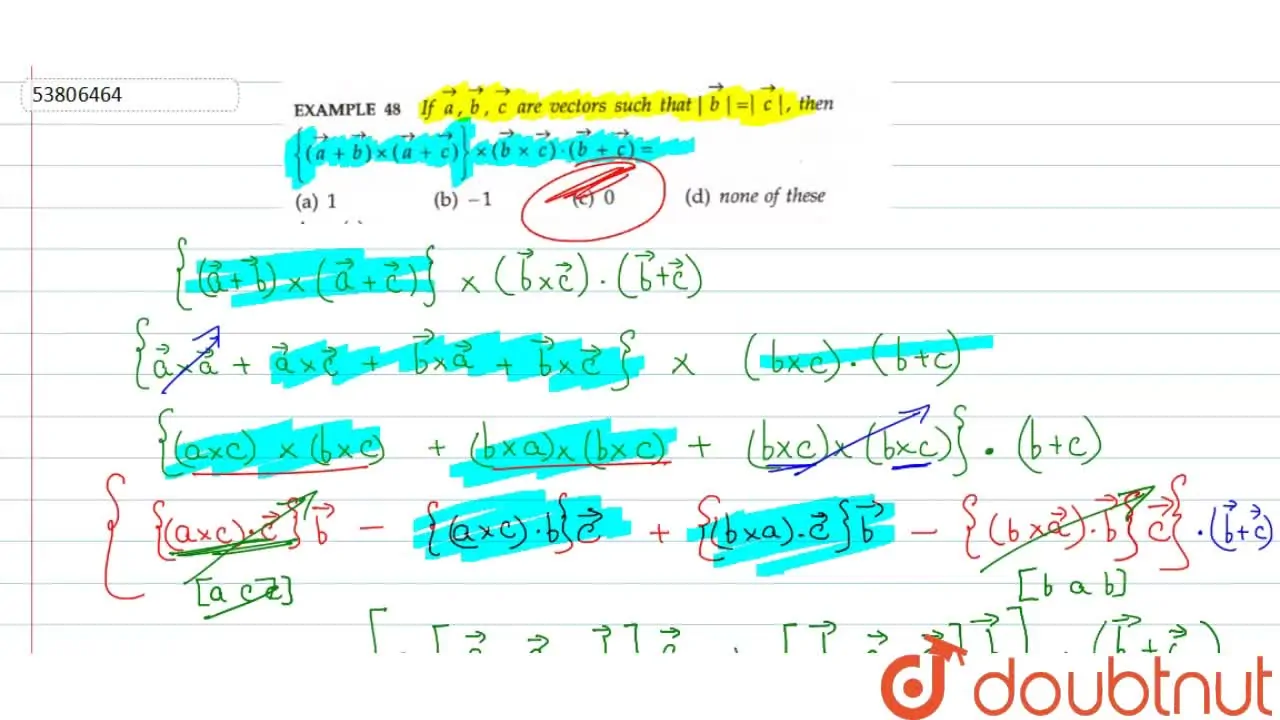If →a,→b,→c are vectors such that ∣∣→b∣∣=|→c| then {(→a+→b)×(→a+→c)}×(→b×→c).(→b+→c)=
1
−1
0
none of these
The correct Answer is:C
We have
{(→a+→b)×(→a+→c)}×(→b×→c).(→b+→c)
=(→a×→c+→b×→a+→b×→c)×(→b×→c).(→b+→c)
⇒(→a×→c+→b×→a+→b×→c)×(→b×→c).(→b+→c)
={(→a×→c)×(→b×→c)+(→b×→a)×(→b×→c)}.(→b+→c)
=[{(→a×→).→c}→b−{(→a×→c).→b}→c{(→b×→a).→c}→b
−{(→b×→a).→b}→c].(→b+→c)
={−[→a→c→b]→c+[→b→a→c]→b}.(→b+→c)
=[→a→b→c]{→c.(→b+→a)}−[→a→b→c]{→b.(→b+→c)}
=[→a→b→c][(→c.→b+→c.→c−→b.→b−→.→c)]
[→a→b→c]{|→c|2−∣∣→b∣∣2}=0[∴∣∣→b∣∣=|→c|]
Related Playlists
- BOOK - OBJECTIVE RD SHARMACHAPTER - SCALAR AND VECTOR PRODUCTS OF THREE VECTORS EXERCISE - Section II - Assertion Reason Type12videos
SCALAR AND VECTOR PRODUCTS OF THREE VECTORS
- BOOK - OBJECTIVE RD SHARMACHAPTER - SCALAR AND VECTOR PRODUCTS OF THREE VECTORS EXERCISE - Exercise65videos
SCALAR AND VECTOR PRODUCTS OF THREE VECTORS
- BOOK - OBJECTIVE RD SHARMACHAPTER - SCALAR AND VECTOR PRODUCTS OF THREE VECTORS EXERCISE - Exercise65videos
SCALAR AND VECTOR PRODUCTS OF THREE VECTORS
- BOOK - OBJECTIVE RD SHARMACHAPTER - REAL FUNCTIONS EXERCISE - Chapter Test60videos
REAL FUNCTIONS
- BOOK - OBJECTIVE RD SHARMACHAPTER - SCALER AND VECTOR PRODUCTS OF TWO VECTORS EXERCISE - Section I - Solved Mcqs12videos
SCALER AND VECTOR PRODUCTS OF TWO VECTORS
Similar Questions
If →a,→b,→c are vectors such that →a.→b=0 and →a+→b=→c then:
View SolutionIf →a,→band→c are three vectors such that →a×→b=→c,→b×→c=→a,→c×→a=→b then prove that |→a|=∣∣→b∣∣=|→c|
View SolutionIf →a,→band→c are three vectors such that →a×→b=→c,→b×→c=→a,→c×→a=→b then prove that |→a|=∣∣→b∣∣=|→c|
View SolutionLet →aand→b are vectors such that |→a|=2,∣∣→b∣∣=3and→a.→b=4. If →c=(3→a×→b)−4→b, then |→c| is equal to
View SolutionIf →a,→band→c are unit vectors such that →a+→b+→c=0, then the value of →a.→b+→b.→c+→c.→a is
View SolutionIf the vectors →a,→b,and→c are coplanar show that ∣∣ ∣ ∣∣→a→b→c→a.→a→a.→b→a.→c→b.→a→b.→b→b.→c∣∣ ∣ ∣∣=0
View SolutionIf →a,→b,→c are unit vectors such that →a.→b=0,(→a−→c).(→b+→c)=0 and →c=λ→a+μ→b+ω(→a×→b), where λ,μ,ω are scalars, then
View SolutionIf →a,→b,→cand→d ar distinct vectors such that →a×→c=→b×→dand→a×→b=→c×→d. Prove that (→a−→d).(→c−→b)≠0,i.e.,→a.→b+→d.→c≠→d.→b+→a.→c.
View SolutionIf →a,→b,→c are coplanar vectors , then show that ∣∣ ∣ ∣∣→a→b→c→a⋅→a→a⋅→b→a⋅→c→b⋅→a→b⋅→b→b⋅→c∣∣ ∣ ∣∣=→0
View SolutionIf →a,→b,→c are any three non coplanar vectors, then
(→a+→b+→c).(→b+→c)×(→c+→a)View Solution


